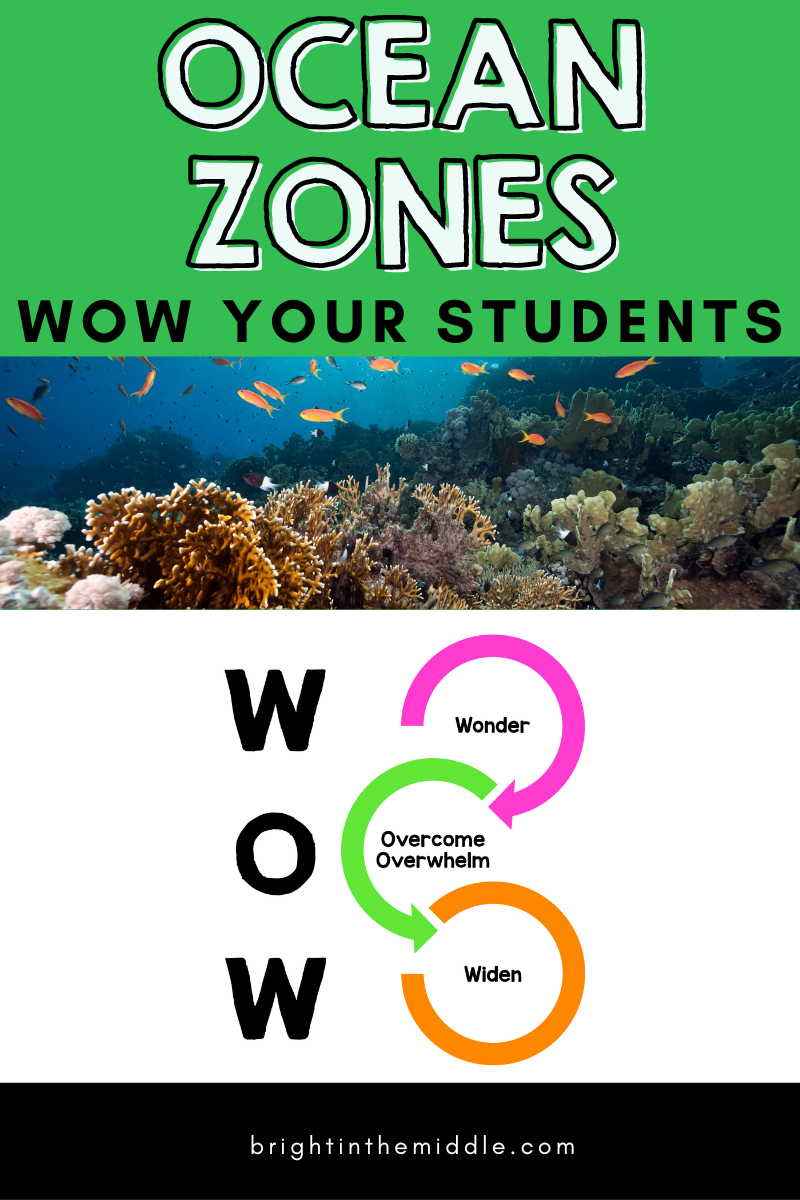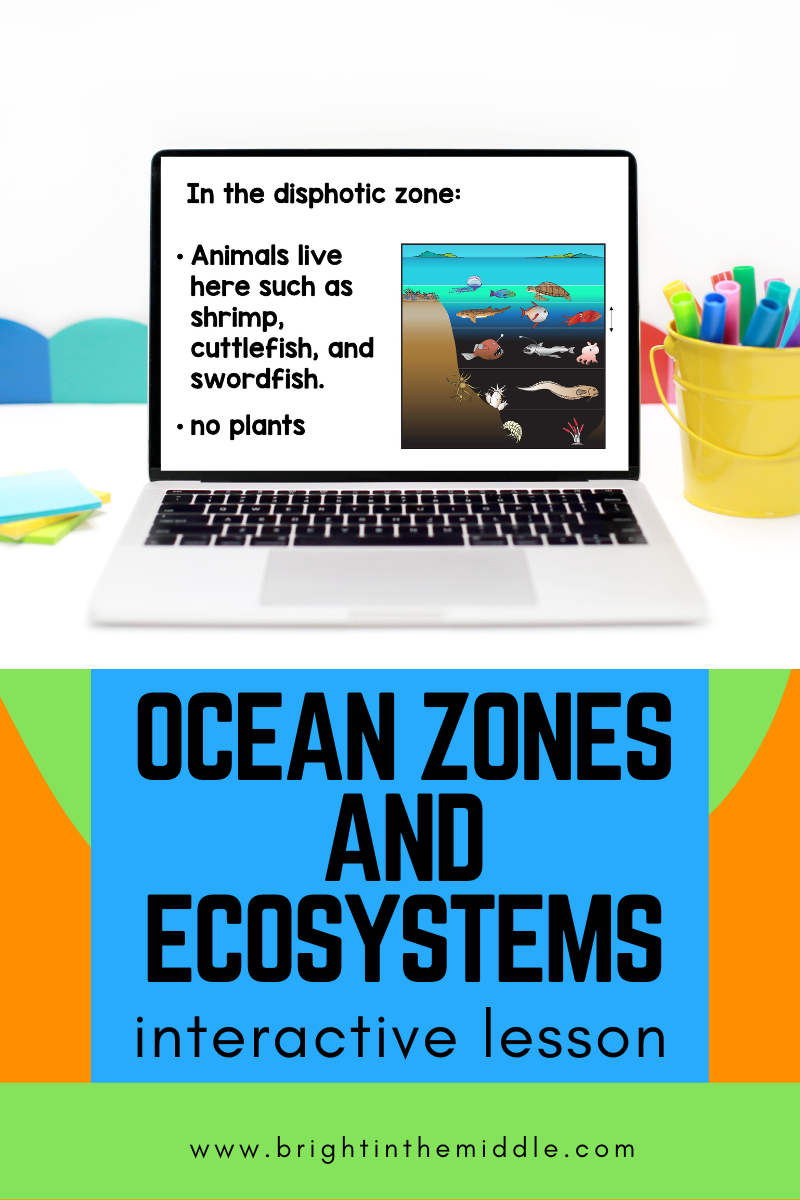Ocean zones are such a neat topic to talk about. Well, the ocean in general is fascinating. There is so much information that scientists have learned about over the years. It’s wild to think that there is SO much more that we do not know about. There is so much space that oceans take up and so many unique organisms that we have never seen before.
The ocean is divided into different zones based on light, habitat, and lifestyle. To understand the diverse life of the ocean and the resources that are available, it’s important to understand the structure.
Time to bring the WOW Factor! In this post, I share first how to introduce your students to ocean life zones using WONDER strategies to help them become internally motivated to learn more about the topic. Second, I will share an interactive lesson on ocean zones and ecosystems that will help your students learn the content without all of the overwhelm of information. Finally, I will share some WIDEN strategies to WIDEN your students’ knowledge on this topic!
What will you add to your ocean zones lesson plans? There are so many neat things that you can do. Your students will absolutely love them!

Ocean Zones WONDER Activities
WONDER activities are introductory activities for your students to help phase in the topic while getting your students excited to learn more and have that buy-in. Here are three things you can do before teaching ocean zones and the ecosystems. You can choose to do just one, or you can do all three!
Virtual Field Trip Inside the Ocean
Before learning about the zones in the ocean, let’s look at the ocean.
There is this already-created virtual field trip on Google Earth.
Students can check out the wonders found in the ocean in different areas of the world such as the Caribbean, Brazil, Australia, and the United States.
They can click on an area they are interested in, such as the Galápagos Islands. Once they click on it, they’ll be taken to a photo sphere where they can look around the area. There is also a description of what the photo is about. It’s so cool!
Each area has many images to scroll through.
Once they are finished with the area, they can click TABLE OF CONTENTS and explore another area. There is SO much to explore!
After students are given a chance to explore, discuss how the majority of the images include a lot of light. Explain that much of the ocean is not exposed to sunlight. Ask students what organisms may be found there and see what they come up with!
Ocean Zones Activity – Where Do They Live?
Let students know that the ocean is divided into zones based on different things, and one of those is light. There are three zones: photic, disphotic, aphotic.
1. Prepare sets of cards with different ocean animals. Some examples include:
- phytoplankton (photic zone)
- zooplankton (photic zone)
- sharks (photic zone)
- sea lions (photic zone)
- turtles (photic zone)
- brittle star (disphotic zone)
- cuttlefish (disphotic zone)
- eels (disphotic zone)
- opah (disphotic zone)
- viperfish (disphotic zone)
- anglerfish (aphotic zone)
- sea cucumber (aphotic zone)
- basket stars (aphotic zone)
- tube worms (aphotic zone)
- giant squid (aphotic zone)
2. Make enough sets of cards for groups or partners in your classroom.
3. Let your students know that the ocean is broken up into 3 zones based on light level: sunlight reaches, sunlight sometimes reaches, and sunlight doesn’t reach. You can tell them the names, or not! It’s up to you. You’ll dive in more when you begin the lesson.
4. Give each group a set of cards and have them split the organisms into the zones that they think they are in.
It’s a fun activity, especially because it will get students thinking about what adaptations may be needed for organisms to survive with no sunlight! They’re creating their own ocean zones graphic organizer.

Great Tube Worms Post-It Discussion
Great tube worms are the neatest little (well, giant) things. They are creatures that hang around hydrothermal vents. How in the world do they survive down at the bottom of the ocean?
- Give each of your students a post-it note.
- Show them a picture of a tube worm.
- Ask them this question, “These tube worms live in complete darkness. They live in the aphotic zone. These organisms can’t eat. How do you think they survive?”.
- Have students write their answer on their post-it notes. It will be so awesome to see their ideas in action.
- Once they finish, they can bring their post-it note to a designated spot on the wall.
- You or a student volunteer can then read some of the answers and see if there are any patterns in their answers.
At this point, you can choose to explain the answer to students, wait until the lesson (because they are curious now), or show them this helpful video!
Ocean Zones and Ecosystems Interactive Lesson
Interactive lessons are the best for teaching content, whether it is for independent learning or direct instruction.
They are set up to where the content is given, but within the lesson, there are embedded activities for students to work through to help them process the content before moving on. This reduces cognitive load, which will help them to remember things and store them in their long-term memory!

This Ocean Zones and Ecosystem Interactive Lesson is set in this way. This lesson covers Earth’s oceans, ocean basins, marine ecosystems, ocean zones definition, ocean zones facts, the shore, photic zone, disphotic zone, and aphotic zone. It discusses how organisms have to adapt to the different zones. The lesson also explores plankton, nekton, and benthos in aquatic food webs and food chains. There is an ocean zones diagram to help them make connections.
There’s more too!
The embedded activities include an anticipation guide, drag-and-drop activities, a Venn diagram, typing in the text box, and more!
Skip the oceans zones worksheet, and try this out!
You can check this resource out in the Bright in the Middle Shop.
You can also get this on TPT.
Ocean Zones Lesson Ideas for WIDENING Knowledge
If time allows, it’s always great for students to go above and beyond to expand their knowledge. Of course, time is not always something we have, but these can also be used as projects outside of class or however you wish. Here are some WIDEN activities for ocean zones.
Marine Life Research
One of the things you can do to expand student knowledge is to allow them to research a specific organism in one of the ocean zones of their choice.
The really extreme organisms are always interesting.
They can work individually, in partners, or in groups to do this research project.
They can research the organisms habitat, diet and role in the food web, and adaptations.
Once they have collected the information they need, they can put it in presentation form to share with the class. This could be a slides presentation, a brochure, a song, or whatever presentation style you or the student chooses.
This is a fun way to learn about the unique organisms in the ocean as well as the ecosystems!
Guest Speaker – Marine Biologist
Another thing you can do, which is always a good thing to do, is invite a guest speaker to share their expertise with your students.
A marine biologist would be awesome! If you cannot find one locally, check out some virtual options.
Marine biologists may be able to share the different technology that is used to study the organisms in the ocean. They will likely have some neat things to share.
You can check out resources such as Skype a Scientist.
Ocean Zones Project – Field Guide
Have your students ever been exposed to a field guide? Here’s your chance to introduce them and have them create one.
You can have them create one that is very simple, or you can have them to create one that is more complex with information about the different organisms.
A field guide is a page, brochure, book, etc. designed to help you identify organisms in the environment.
Here’s an example of a more complex field guide. You can read a sample and show students.
Here is something that is a lot simpler.
- Tell students to imagine that they could swim in the ocean from top to the very bottom.
- Have them to create a field guide to help swimmer’s to identify what organisms they may see.
- You can split students up into groups and have them choose a zone to create their field guide for.
- You can have them make a field guide for just fish, just marine life, just marine invertebrates, etc.
- They can draw these on their own, print things out, or they can create their field guide online. They could make an oceans zones printable field guide!
This is such a flexible project, and students will have fun learning about the ocean zones animals and plants that live in the ocean!
Help your students master science content!



[…] Ocean Zones and Ecosystems […]